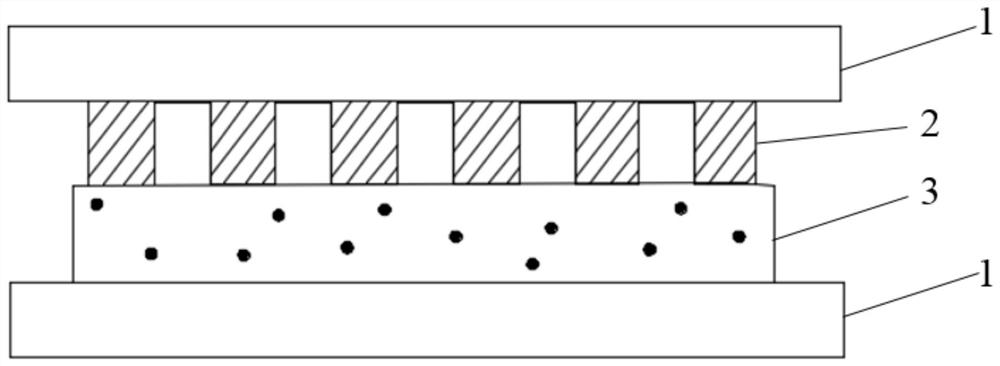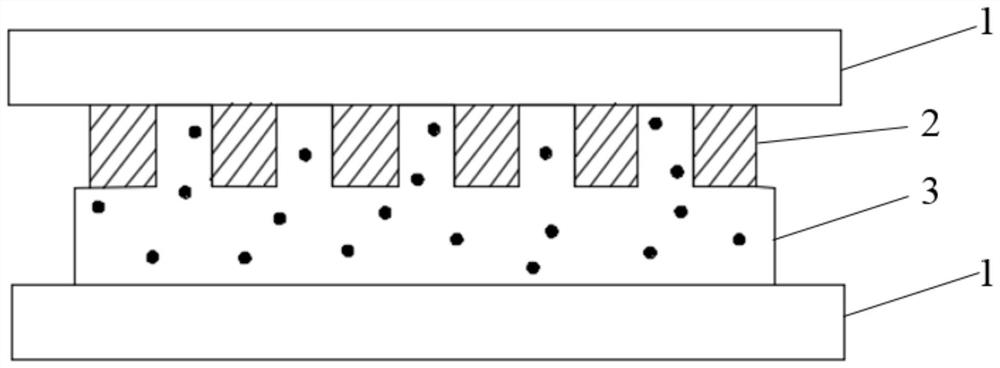A kind of connection method of palladium-based alloy thin film and porous stainless steel carrier
A palladium-based alloy and connection method technology, applied in welding equipment, metal processing equipment, welding/welding/cutting items, etc., can solve the problem of affecting the connection strength and bonding rate of composite membranes, affecting the hydrogen permeability of composite membranes, and local pressure loading No more problems, achieve high density, good deformation ability, and ensure effective welding effect
- Summary
- Abstract
- Description
- Claims
- Application Information
AI Technical Summary
Problems solved by technology
Method used
Image
Examples
Embodiment 1
[0041] The palladium composite membrane in this embodiment is formed by connecting a Pd77Ag23 thin film and a 316L porous stainless steel carrier, wherein the thickness of the Pd77Ag23 thin film is 20 μm, and the thickness of the 316L porous stainless steel carrier is 0.1 mm.
[0042] The connection method of the Pd77Ag23 film of the present embodiment and the 316L porous stainless steel carrier comprises the following steps:
[0043] Step 1. Prepare the pressure transmission material: choose TSX-1260 aluminum silicate fiber paper with a thickness of 2mm, sandwich the aluminum silicate fiber paper between the polished and polished quartz glass, and place it in an electric furnace for sintering , the temperature in the electric furnace was raised to 540 °C, then kept for 40 minutes, and then cooled to 150 °C with the furnace to get the pressure transfer material;
[0044] Step 2, pressing: place the pressure-transmitting material obtained in step 1 on the upper surface of the g...
Embodiment 2
[0049] The palladium composite membrane in this embodiment is formed by connecting a Pd90Y10 thin film and a 304 porous stainless steel carrier, the thickness of the Pd90Y10 thin film is 15 μm, and the thickness of the 304 porous stainless steel carrier is 0.15 mm.
[0050] The connection method of the Pd90Y10 film of the present embodiment and the 304 porous stainless steel carrier comprises the following steps:
[0051] Step 1. Prepare pressure transmission materials: choose TSX-1400 aluminum silicate fiber paper with a thickness of 2mm, sandwich the aluminum silicate fiber paper between the polished and polished quartz glass, and place it in an electric furnace for sintering , the temperature in the electric furnace was raised to 580 °C, then kept for 60 minutes, and then cooled to 120 °C with the furnace to get the pressure transfer material;
[0052] Step 2, pressing: place the pressure-transmitting material obtained in step 1 on the upper surface of the ground and polish...
Embodiment 3
[0057] The palladium composite membrane in this embodiment is formed by connecting a Pd60Cu40 thin film and a 316L porous stainless steel carrier, the thickness of the Pd60Cu40 thin film is 10 μm, and the thickness of the 304 porous stainless steel carrier is 0.2 mm.
[0058] The connection method of the Pd60Cu40 film of the present embodiment and the 316L porous stainless steel carrier comprises the following steps:
[0059] Step 1. Prepare pressure transmission materials: choose TSX-1400 aluminum silicate fiber paper with a thickness of 2mm, sandwich the aluminum silicate fiber paper between the polished and polished quartz glass, and place it in an electric furnace for sintering , the temperature in the electric furnace was raised to 560 °C, then kept for 50 minutes, and then cooled to 30 °C with the furnace to get the pressure transfer material;
[0060] Step 2, pressing: place the pressure-transmitting material obtained in step 1 on the upper surface of the ground and pol...
PUM
| Property | Measurement | Unit |
|---|---|---|
| thickness | aaaaa | aaaaa |
| thickness | aaaaa | aaaaa |
| thickness | aaaaa | aaaaa |
Abstract
Description
Claims
Application Information
 Login to View More
Login to View More - R&D
- Intellectual Property
- Life Sciences
- Materials
- Tech Scout
- Unparalleled Data Quality
- Higher Quality Content
- 60% Fewer Hallucinations
Browse by: Latest US Patents, China's latest patents, Technical Efficacy Thesaurus, Application Domain, Technology Topic, Popular Technical Reports.
© 2025 PatSnap. All rights reserved.Legal|Privacy policy|Modern Slavery Act Transparency Statement|Sitemap|About US| Contact US: help@patsnap.com



